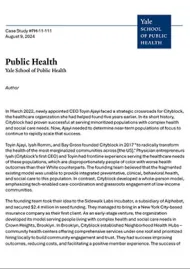Girl Effect

In early 2025, Chief Creative and Technology Officer Karina Rios Michel stood at a pivotal moment for Girl Effect’s flagship chatbot, Big Sis. Rapid advances in generative Artificial Intelligence (AI), growing demand for scalable digital solutions, and new partnership opportunities were opening doors for global innovation in adolescent health. At the same time, shifts in donor priorities, including historic reductions in global health funding, challenged the organization to reassess how best to sustain and expand its mission-driven platform. With the pace of advances in AI and machine learning accelerating, the stakes were rising for keeping Girl Effect’s technology current and competitive. The organization now confronted a central strategic question: how to sustain and scale its mission-driven AI platform in an evolving global health and technology landscape.
Founded in 2004 by the Nike Foundation, Girl Effect evolved from a media-based behavior change initiative into a global organization focused on adolescent girls’ empowerment. Its early success came through locally grounded platforms like Ni Nyampinga in Rwanda and in Ethiopia, which combined storytelling and brand-building to challenge gender norms and expand access to health, education and livelihoods. By the mid-2010s, Girl Effect had become an independent nonprofit and established partnerships with major global institutions including the Gates Foundation, GAVI, and UNICEF.
As mobile phone access and connectivity expanded, Girl Effect shifted toward digital innovation. In 2018, it launched Big Sis, a WhatsApp-based chatbot designed with and for girls in South Africa, offering anonymous and culturally attuned guidance on sensitive health topics. The model expanded to India (Bol Behen), and the platform became available across messaging apps like Facebook Messenger, Moya, and Telegram. By 2024, Big Sis had reached 1.5 million users and handled more than 35 million messages in multiple languages by embedding advancements in large language models (LLMs) and retrieval-augmented generation (RAG) into the chatbot.
Girl Effect’s leadership and board are exploring strategic pathways to sustain and grow the platform. The organization’s CEO has tasked Karina to lead a cross-functional team in evaluating options and recommending a course of action—assessing trade-offs across mission alignment, sustainability, and impact. Philanthropic donors interested in Girl Effect’s model seek rigorous evidence of downstream impact—especially randomized controlled trials (RCTs)—before committing further investment. This path would preserve the nonprofit structure, focusing on securing funding for an RCT to validate Big Sis's effectiveness. However, an RCT focused strategy would likely require narrowing geographic focus and slowing expansion, with no guarantee of immediate donor support.
A second option involves keeping Big Sis within Girl Effect while developing income-generating models and exploring new forms of catalytic capital. With growing interest in mission-aligned technology for adolescent health, blended-finance approaches—such as recoverable grants, impact investments, and innovation-linked funding—are becoming more viable. This strategy could include licensing, white-labeling, or public-sector partnerships, while preserving nonprofit ownership and Girl Effect’s commitment to impact, data privacy, and brand integrity. It would also require building internal capacity to test revenue models, manage cross-sector funder expectations, and stay focused on girls’ needs. A third option, exploring a deep strategic partnership with another aligned nonprofit, is also on the table—though peers with comparable reach and digital capabilities are limited.
The challenge is no longer simply about scale or impact, but how to evolve and sustain a mission-driven innovation amid shifting dynamics in funding, technology, and global health—while staying true to Girl Effect’s two-decade legacy of designing with and for girls.